Consumer Behaviour and its Impact on Vacation, Cosmetic and Precooked Food Industries in Australia and New Zealand
VerifiedAdded on 2023/06/07
|8
|2034
|101
AI Summary
This article discusses the impact of consumer behaviour on vacation, cosmetic and precooked food industries in Australia and New Zealand. It covers the impacts of senior citizens, baby boomers, generation Y, and smaller unit families on these industries. Other factors affecting these industries are also discussed.
Contribute Materials
Your contribution can guide someone’s learning journey. Share your
documents today.
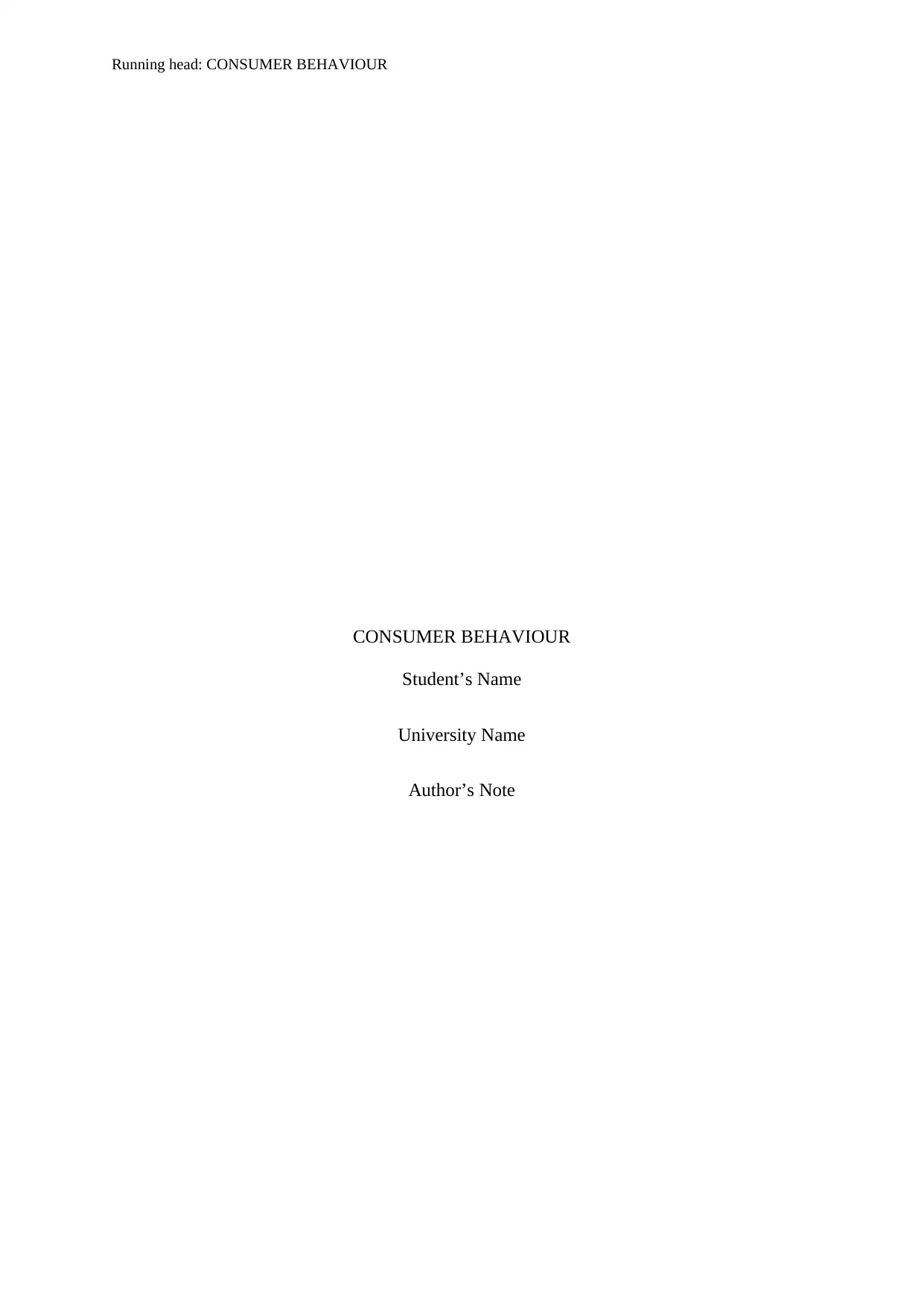
Running head: CONSUMER BEHAVIOUR
CONSUMER BEHAVIOUR
Student’s Name
University Name
Author’s Note
CONSUMER BEHAVIOUR
Student’s Name
University Name
Author’s Note
Secure Best Marks with AI Grader
Need help grading? Try our AI Grader for instant feedback on your assignments.
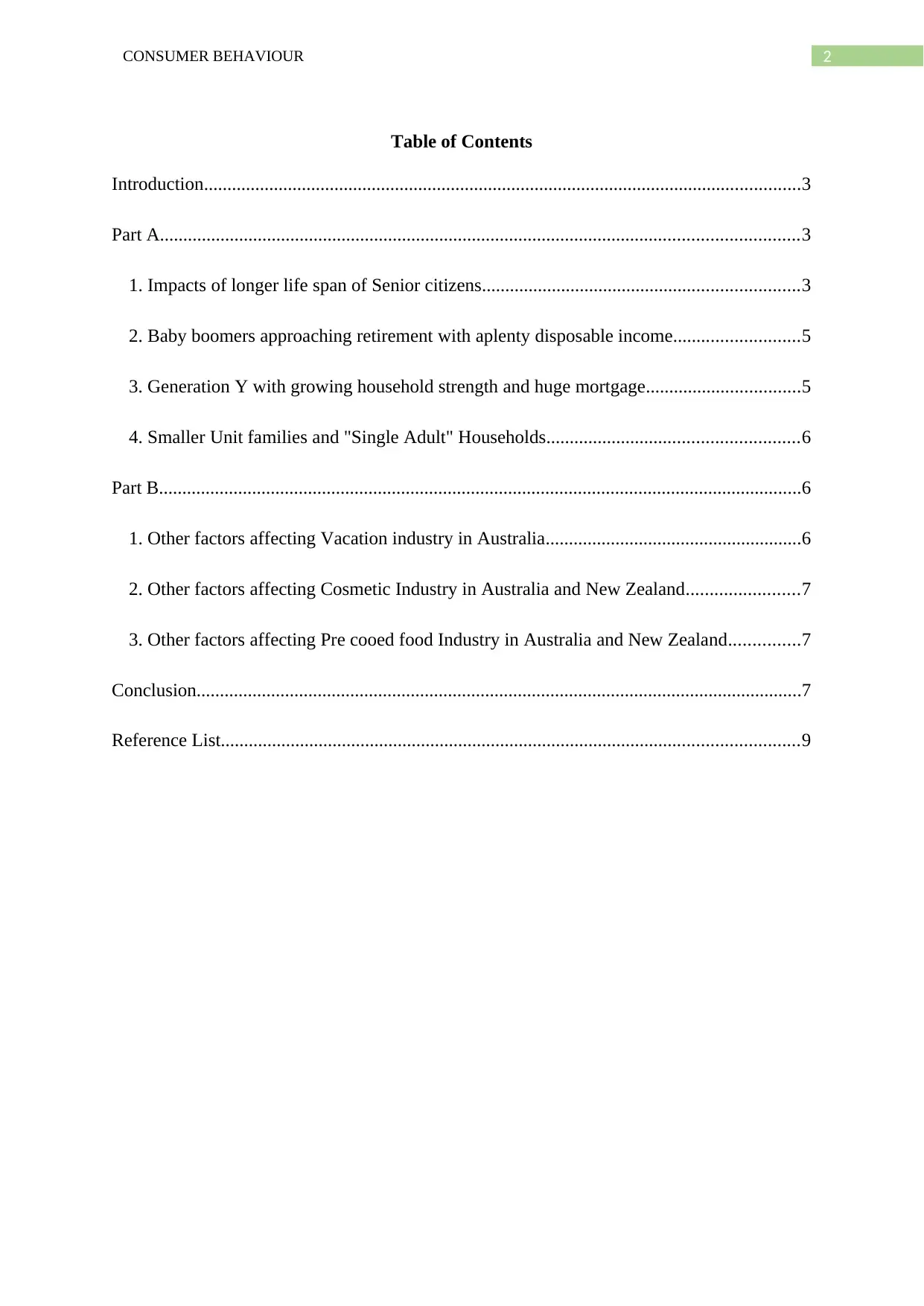
2CONSUMER BEHAVIOUR
Table of Contents
Introduction................................................................................................................................3
Part A.........................................................................................................................................3
1. Impacts of longer life span of Senior citizens....................................................................3
2. Baby boomers approaching retirement with aplenty disposable income...........................5
3. Generation Y with growing household strength and huge mortgage.................................5
4. Smaller Unit families and "Single Adult" Households......................................................6
Part B..........................................................................................................................................6
1. Other factors affecting Vacation industry in Australia.......................................................6
2. Other factors affecting Cosmetic Industry in Australia and New Zealand........................7
3. Other factors affecting Pre cooed food Industry in Australia and New Zealand...............7
Conclusion..................................................................................................................................7
Reference List............................................................................................................................9
Table of Contents
Introduction................................................................................................................................3
Part A.........................................................................................................................................3
1. Impacts of longer life span of Senior citizens....................................................................3
2. Baby boomers approaching retirement with aplenty disposable income...........................5
3. Generation Y with growing household strength and huge mortgage.................................5
4. Smaller Unit families and "Single Adult" Households......................................................6
Part B..........................................................................................................................................6
1. Other factors affecting Vacation industry in Australia.......................................................6
2. Other factors affecting Cosmetic Industry in Australia and New Zealand........................7
3. Other factors affecting Pre cooed food Industry in Australia and New Zealand...............7
Conclusion..................................................................................................................................7
Reference List............................................................................................................................9
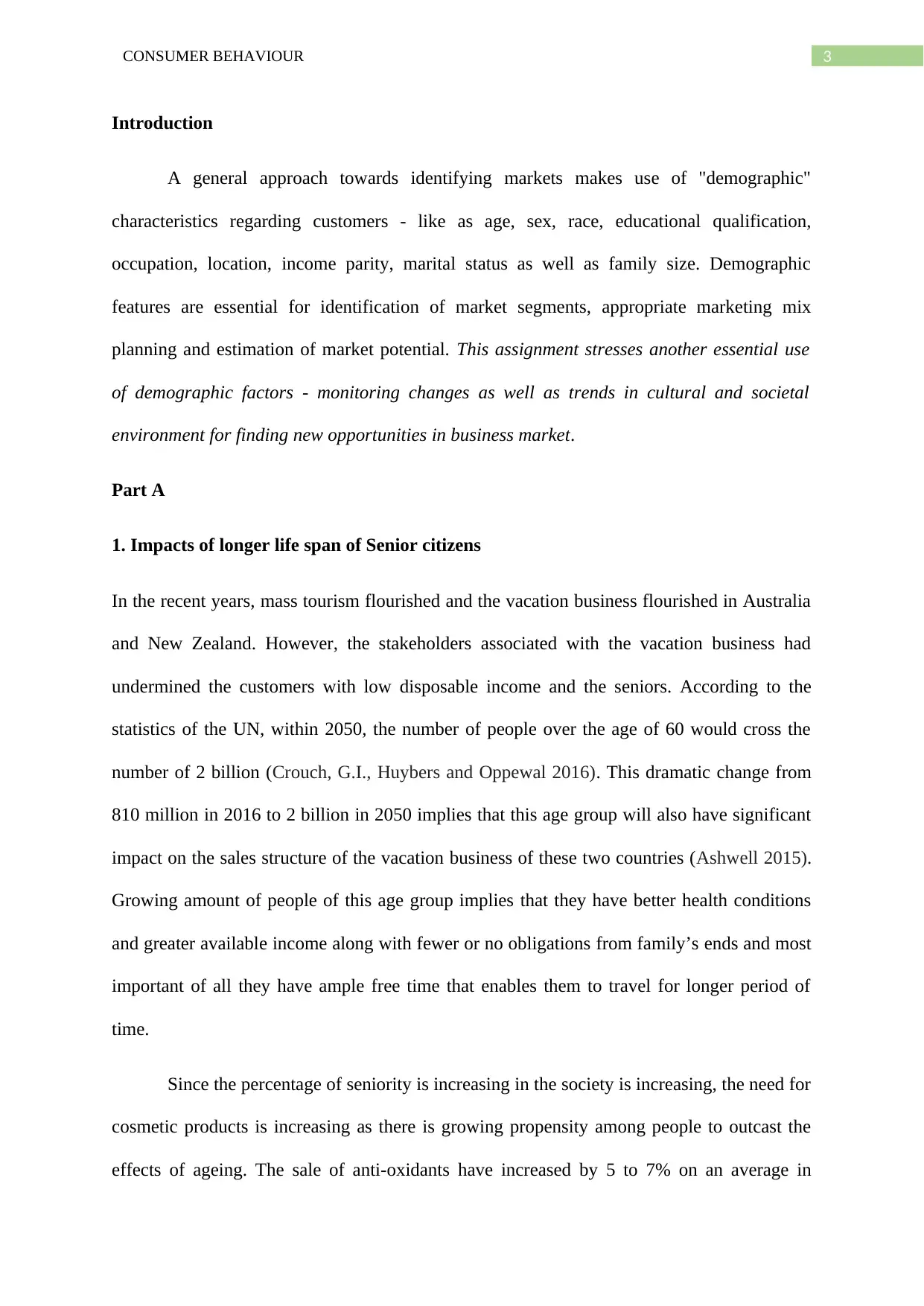
3CONSUMER BEHAVIOUR
Introduction
A general approach towards identifying markets makes use of "demographic"
characteristics regarding customers - like as age, sex, race, educational qualification,
occupation, location, income parity, marital status as well as family size. Demographic
features are essential for identification of market segments, appropriate marketing mix
planning and estimation of market potential. This assignment stresses another essential use
of demographic factors - monitoring changes as well as trends in cultural and societal
environment for finding new opportunities in business market.
Part A
1. Impacts of longer life span of Senior citizens
In the recent years, mass tourism flourished and the vacation business flourished in Australia
and New Zealand. However, the stakeholders associated with the vacation business had
undermined the customers with low disposable income and the seniors. According to the
statistics of the UN, within 2050, the number of people over the age of 60 would cross the
number of 2 billion (Crouch, G.I., Huybers and Oppewal 2016). This dramatic change from
810 million in 2016 to 2 billion in 2050 implies that this age group will also have significant
impact on the sales structure of the vacation business of these two countries (Ashwell 2015).
Growing amount of people of this age group implies that they have better health conditions
and greater available income along with fewer or no obligations from family’s ends and most
important of all they have ample free time that enables them to travel for longer period of
time.
Since the percentage of seniority is increasing in the society is increasing, the need for
cosmetic products is increasing as there is growing propensity among people to outcast the
effects of ageing. The sale of anti-oxidants have increased by 5 to 7% on an average in
Introduction
A general approach towards identifying markets makes use of "demographic"
characteristics regarding customers - like as age, sex, race, educational qualification,
occupation, location, income parity, marital status as well as family size. Demographic
features are essential for identification of market segments, appropriate marketing mix
planning and estimation of market potential. This assignment stresses another essential use
of demographic factors - monitoring changes as well as trends in cultural and societal
environment for finding new opportunities in business market.
Part A
1. Impacts of longer life span of Senior citizens
In the recent years, mass tourism flourished and the vacation business flourished in Australia
and New Zealand. However, the stakeholders associated with the vacation business had
undermined the customers with low disposable income and the seniors. According to the
statistics of the UN, within 2050, the number of people over the age of 60 would cross the
number of 2 billion (Crouch, G.I., Huybers and Oppewal 2016). This dramatic change from
810 million in 2016 to 2 billion in 2050 implies that this age group will also have significant
impact on the sales structure of the vacation business of these two countries (Ashwell 2015).
Growing amount of people of this age group implies that they have better health conditions
and greater available income along with fewer or no obligations from family’s ends and most
important of all they have ample free time that enables them to travel for longer period of
time.
Since the percentage of seniority is increasing in the society is increasing, the need for
cosmetic products is increasing as there is growing propensity among people to outcast the
effects of ageing. The sale of anti-oxidants have increased by 5 to 7% on an average in
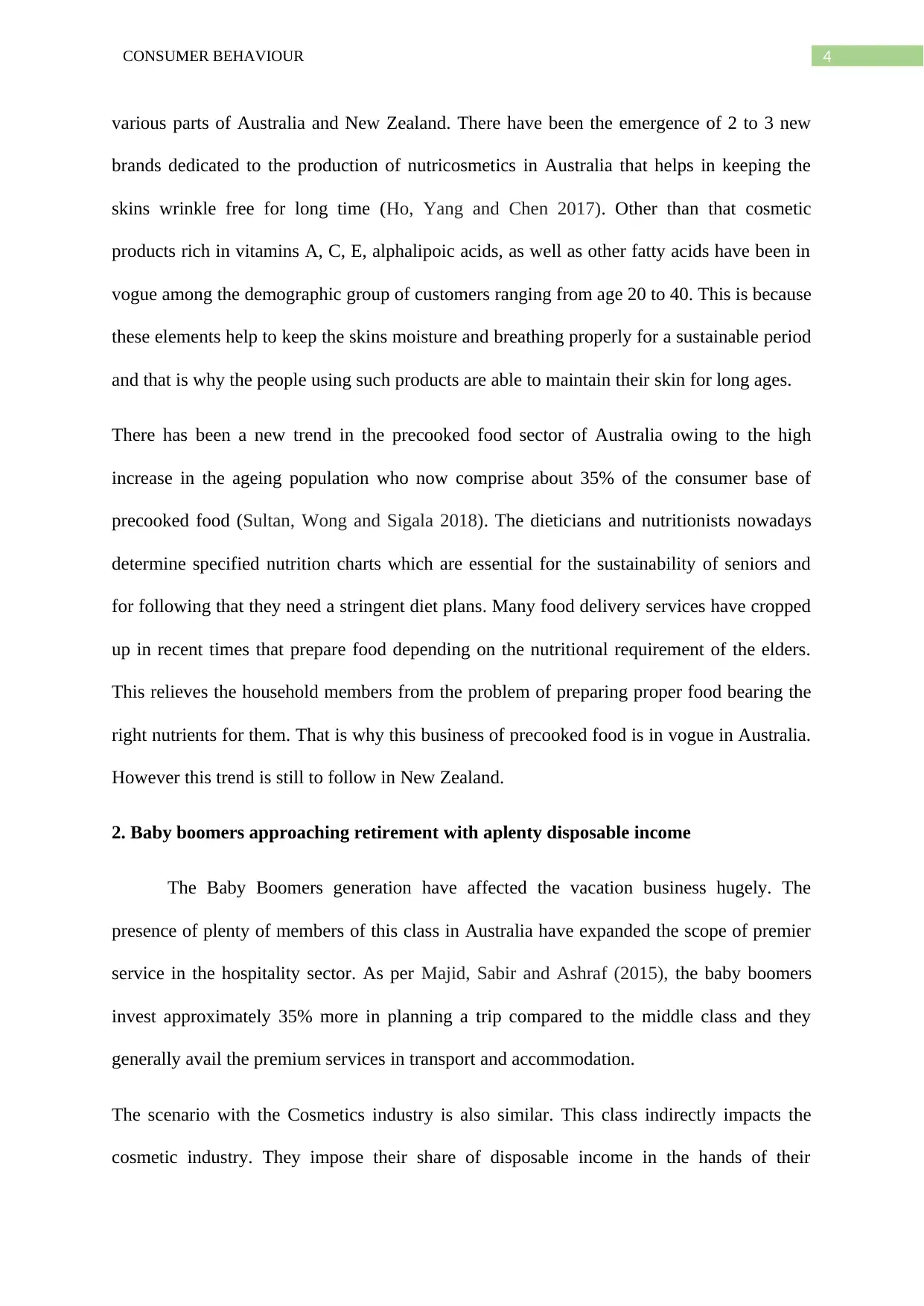
4CONSUMER BEHAVIOUR
various parts of Australia and New Zealand. There have been the emergence of 2 to 3 new
brands dedicated to the production of nutricosmetics in Australia that helps in keeping the
skins wrinkle free for long time (Ho, Yang and Chen 2017). Other than that cosmetic
products rich in vitamins A, C, E, alphalipoic acids, as well as other fatty acids have been in
vogue among the demographic group of customers ranging from age 20 to 40. This is because
these elements help to keep the skins moisture and breathing properly for a sustainable period
and that is why the people using such products are able to maintain their skin for long ages.
There has been a new trend in the precooked food sector of Australia owing to the high
increase in the ageing population who now comprise about 35% of the consumer base of
precooked food (Sultan, Wong and Sigala 2018). The dieticians and nutritionists nowadays
determine specified nutrition charts which are essential for the sustainability of seniors and
for following that they need a stringent diet plans. Many food delivery services have cropped
up in recent times that prepare food depending on the nutritional requirement of the elders.
This relieves the household members from the problem of preparing proper food bearing the
right nutrients for them. That is why this business of precooked food is in vogue in Australia.
However this trend is still to follow in New Zealand.
2. Baby boomers approaching retirement with aplenty disposable income
The Baby Boomers generation have affected the vacation business hugely. The
presence of plenty of members of this class in Australia have expanded the scope of premier
service in the hospitality sector. As per Majid, Sabir and Ashraf (2015), the baby boomers
invest approximately 35% more in planning a trip compared to the middle class and they
generally avail the premium services in transport and accommodation.
The scenario with the Cosmetics industry is also similar. This class indirectly impacts the
cosmetic industry. They impose their share of disposable income in the hands of their
various parts of Australia and New Zealand. There have been the emergence of 2 to 3 new
brands dedicated to the production of nutricosmetics in Australia that helps in keeping the
skins wrinkle free for long time (Ho, Yang and Chen 2017). Other than that cosmetic
products rich in vitamins A, C, E, alphalipoic acids, as well as other fatty acids have been in
vogue among the demographic group of customers ranging from age 20 to 40. This is because
these elements help to keep the skins moisture and breathing properly for a sustainable period
and that is why the people using such products are able to maintain their skin for long ages.
There has been a new trend in the precooked food sector of Australia owing to the high
increase in the ageing population who now comprise about 35% of the consumer base of
precooked food (Sultan, Wong and Sigala 2018). The dieticians and nutritionists nowadays
determine specified nutrition charts which are essential for the sustainability of seniors and
for following that they need a stringent diet plans. Many food delivery services have cropped
up in recent times that prepare food depending on the nutritional requirement of the elders.
This relieves the household members from the problem of preparing proper food bearing the
right nutrients for them. That is why this business of precooked food is in vogue in Australia.
However this trend is still to follow in New Zealand.
2. Baby boomers approaching retirement with aplenty disposable income
The Baby Boomers generation have affected the vacation business hugely. The
presence of plenty of members of this class in Australia have expanded the scope of premier
service in the hospitality sector. As per Majid, Sabir and Ashraf (2015), the baby boomers
invest approximately 35% more in planning a trip compared to the middle class and they
generally avail the premium services in transport and accommodation.
The scenario with the Cosmetics industry is also similar. This class indirectly impacts the
cosmetic industry. They impose their share of disposable income in the hands of their
Secure Best Marks with AI Grader
Need help grading? Try our AI Grader for instant feedback on your assignments.
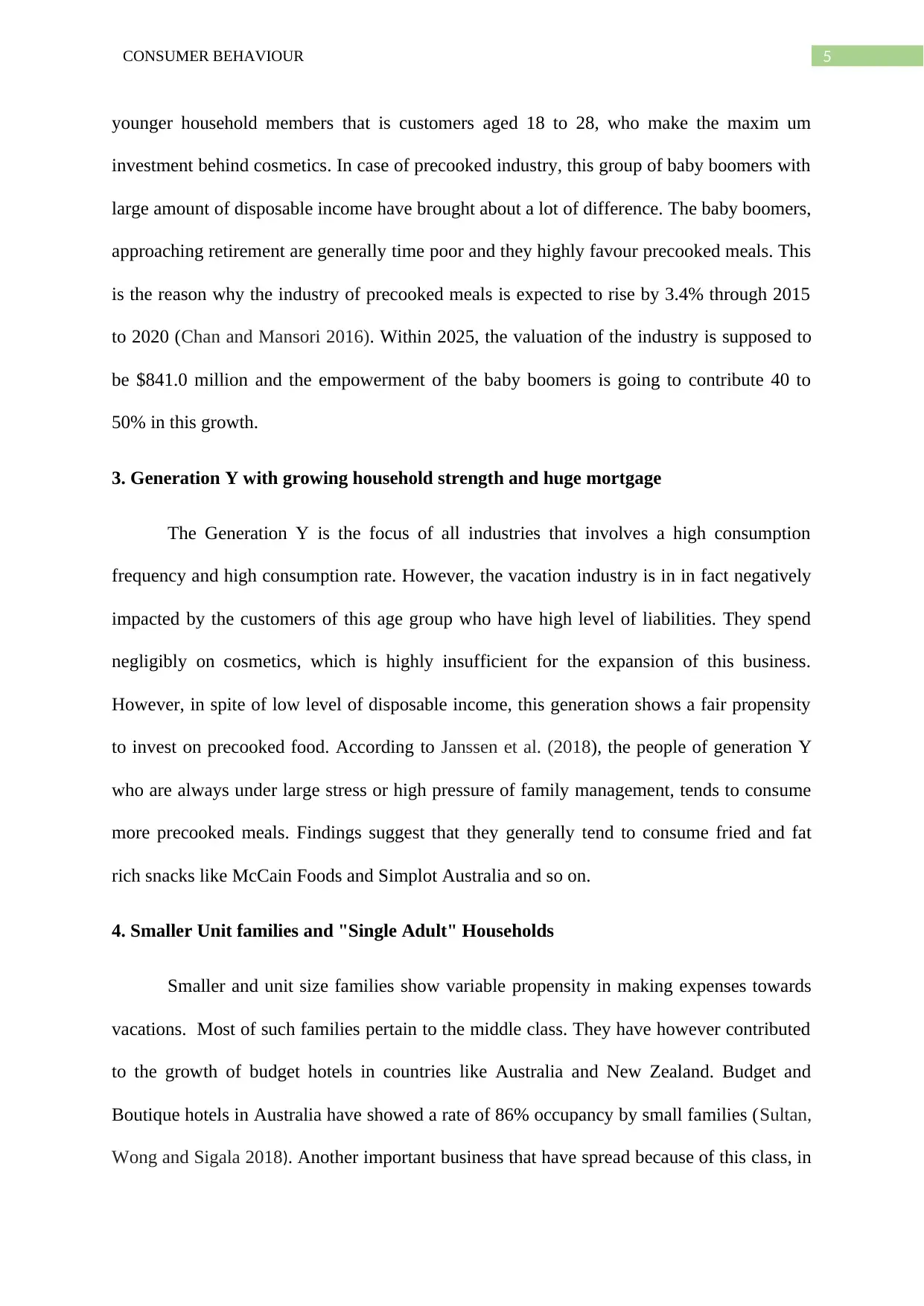
5CONSUMER BEHAVIOUR
younger household members that is customers aged 18 to 28, who make the maxim um
investment behind cosmetics. In case of precooked industry, this group of baby boomers with
large amount of disposable income have brought about a lot of difference. The baby boomers,
approaching retirement are generally time poor and they highly favour precooked meals. This
is the reason why the industry of precooked meals is expected to rise by 3.4% through 2015
to 2020 (Chan and Mansori 2016). Within 2025, the valuation of the industry is supposed to
be $841.0 million and the empowerment of the baby boomers is going to contribute 40 to
50% in this growth.
3. Generation Y with growing household strength and huge mortgage
The Generation Y is the focus of all industries that involves a high consumption
frequency and high consumption rate. However, the vacation industry is in in fact negatively
impacted by the customers of this age group who have high level of liabilities. They spend
negligibly on cosmetics, which is highly insufficient for the expansion of this business.
However, in spite of low level of disposable income, this generation shows a fair propensity
to invest on precooked food. According to Janssen et al. (2018), the people of generation Y
who are always under large stress or high pressure of family management, tends to consume
more precooked meals. Findings suggest that they generally tend to consume fried and fat
rich snacks like McCain Foods and Simplot Australia and so on.
4. Smaller Unit families and "Single Adult" Households
Smaller and unit size families show variable propensity in making expenses towards
vacations. Most of such families pertain to the middle class. They have however contributed
to the growth of budget hotels in countries like Australia and New Zealand. Budget and
Boutique hotels in Australia have showed a rate of 86% occupancy by small families (Sultan,
Wong and Sigala 2018). Another important business that have spread because of this class, in
younger household members that is customers aged 18 to 28, who make the maxim um
investment behind cosmetics. In case of precooked industry, this group of baby boomers with
large amount of disposable income have brought about a lot of difference. The baby boomers,
approaching retirement are generally time poor and they highly favour precooked meals. This
is the reason why the industry of precooked meals is expected to rise by 3.4% through 2015
to 2020 (Chan and Mansori 2016). Within 2025, the valuation of the industry is supposed to
be $841.0 million and the empowerment of the baby boomers is going to contribute 40 to
50% in this growth.
3. Generation Y with growing household strength and huge mortgage
The Generation Y is the focus of all industries that involves a high consumption
frequency and high consumption rate. However, the vacation industry is in in fact negatively
impacted by the customers of this age group who have high level of liabilities. They spend
negligibly on cosmetics, which is highly insufficient for the expansion of this business.
However, in spite of low level of disposable income, this generation shows a fair propensity
to invest on precooked food. According to Janssen et al. (2018), the people of generation Y
who are always under large stress or high pressure of family management, tends to consume
more precooked meals. Findings suggest that they generally tend to consume fried and fat
rich snacks like McCain Foods and Simplot Australia and so on.
4. Smaller Unit families and "Single Adult" Households
Smaller and unit size families show variable propensity in making expenses towards
vacations. Most of such families pertain to the middle class. They have however contributed
to the growth of budget hotels in countries like Australia and New Zealand. Budget and
Boutique hotels in Australia have showed a rate of 86% occupancy by small families (Sultan,
Wong and Sigala 2018). Another important business that have spread because of this class, in
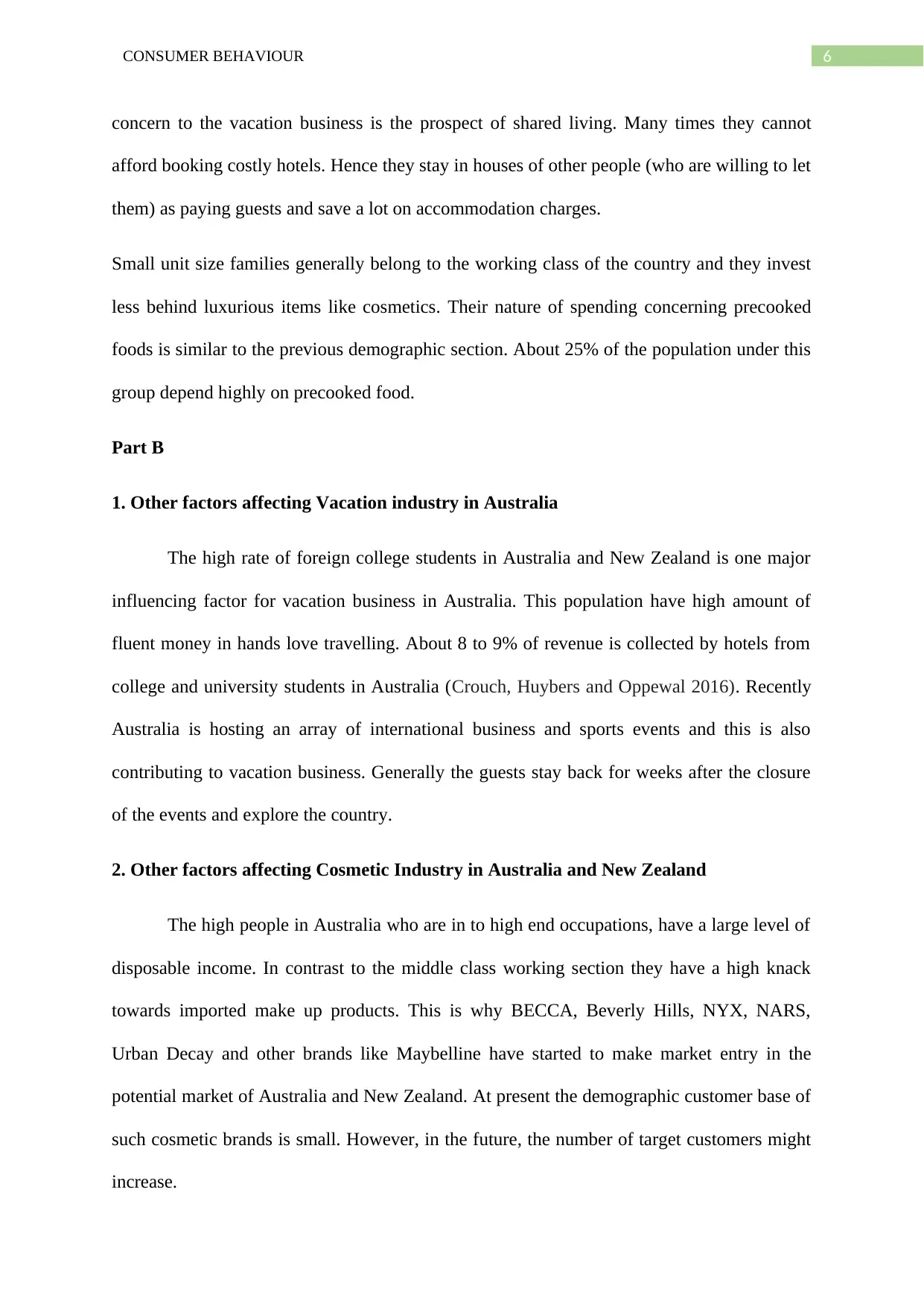
6CONSUMER BEHAVIOUR
concern to the vacation business is the prospect of shared living. Many times they cannot
afford booking costly hotels. Hence they stay in houses of other people (who are willing to let
them) as paying guests and save a lot on accommodation charges.
Small unit size families generally belong to the working class of the country and they invest
less behind luxurious items like cosmetics. Their nature of spending concerning precooked
foods is similar to the previous demographic section. About 25% of the population under this
group depend highly on precooked food.
Part B
1. Other factors affecting Vacation industry in Australia
The high rate of foreign college students in Australia and New Zealand is one major
influencing factor for vacation business in Australia. This population have high amount of
fluent money in hands love travelling. About 8 to 9% of revenue is collected by hotels from
college and university students in Australia (Crouch, Huybers and Oppewal 2016). Recently
Australia is hosting an array of international business and sports events and this is also
contributing to vacation business. Generally the guests stay back for weeks after the closure
of the events and explore the country.
2. Other factors affecting Cosmetic Industry in Australia and New Zealand
The high people in Australia who are in to high end occupations, have a large level of
disposable income. In contrast to the middle class working section they have a high knack
towards imported make up products. This is why BECCA, Beverly Hills, NYX, NARS,
Urban Decay and other brands like Maybelline have started to make market entry in the
potential market of Australia and New Zealand. At present the demographic customer base of
such cosmetic brands is small. However, in the future, the number of target customers might
increase.
concern to the vacation business is the prospect of shared living. Many times they cannot
afford booking costly hotels. Hence they stay in houses of other people (who are willing to let
them) as paying guests and save a lot on accommodation charges.
Small unit size families generally belong to the working class of the country and they invest
less behind luxurious items like cosmetics. Their nature of spending concerning precooked
foods is similar to the previous demographic section. About 25% of the population under this
group depend highly on precooked food.
Part B
1. Other factors affecting Vacation industry in Australia
The high rate of foreign college students in Australia and New Zealand is one major
influencing factor for vacation business in Australia. This population have high amount of
fluent money in hands love travelling. About 8 to 9% of revenue is collected by hotels from
college and university students in Australia (Crouch, Huybers and Oppewal 2016). Recently
Australia is hosting an array of international business and sports events and this is also
contributing to vacation business. Generally the guests stay back for weeks after the closure
of the events and explore the country.
2. Other factors affecting Cosmetic Industry in Australia and New Zealand
The high people in Australia who are in to high end occupations, have a large level of
disposable income. In contrast to the middle class working section they have a high knack
towards imported make up products. This is why BECCA, Beverly Hills, NYX, NARS,
Urban Decay and other brands like Maybelline have started to make market entry in the
potential market of Australia and New Zealand. At present the demographic customer base of
such cosmetic brands is small. However, in the future, the number of target customers might
increase.
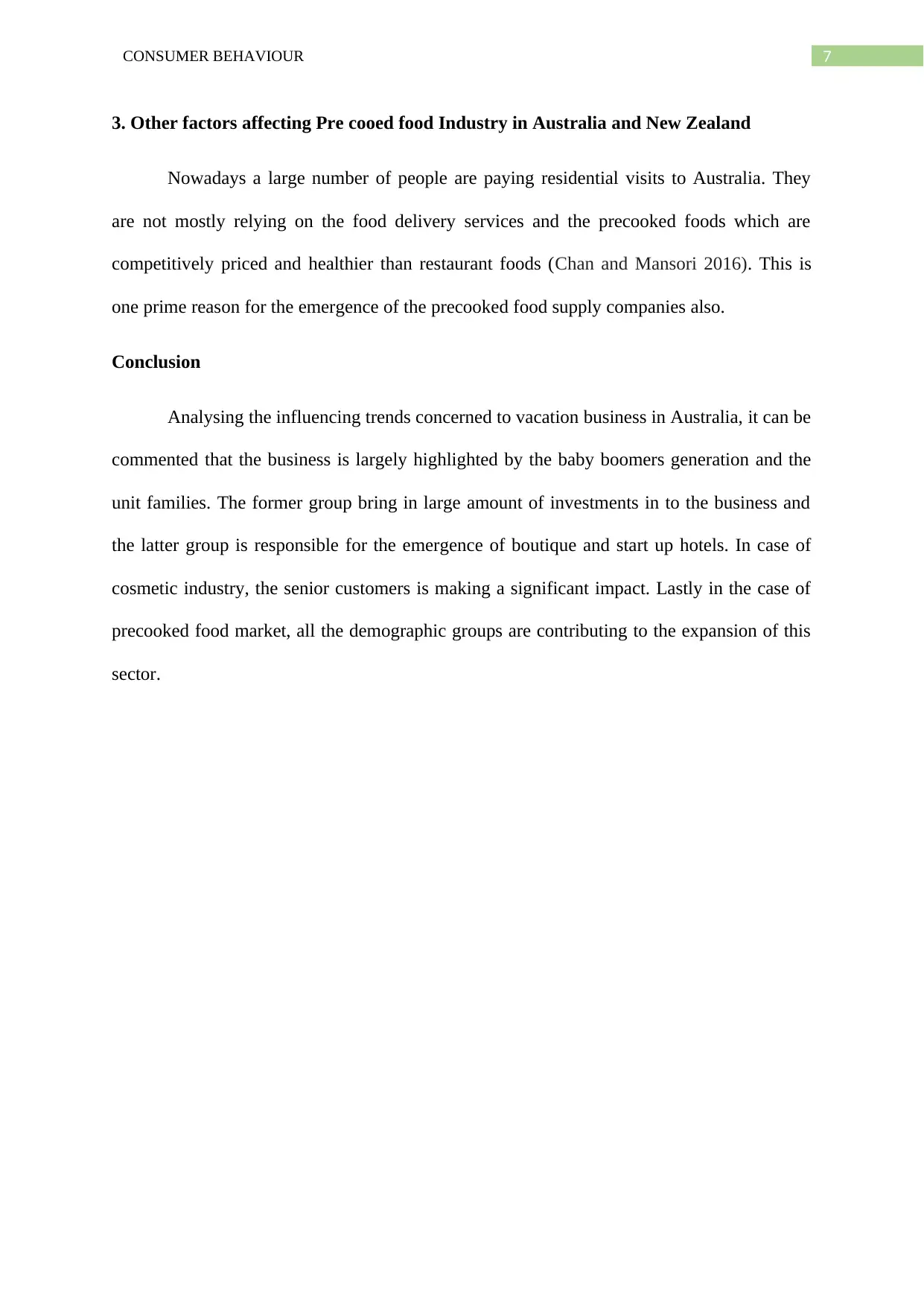
7CONSUMER BEHAVIOUR
3. Other factors affecting Pre cooed food Industry in Australia and New Zealand
Nowadays a large number of people are paying residential visits to Australia. They
are not mostly relying on the food delivery services and the precooked foods which are
competitively priced and healthier than restaurant foods (Chan and Mansori 2016). This is
one prime reason for the emergence of the precooked food supply companies also.
Conclusion
Analysing the influencing trends concerned to vacation business in Australia, it can be
commented that the business is largely highlighted by the baby boomers generation and the
unit families. The former group bring in large amount of investments in to the business and
the latter group is responsible for the emergence of boutique and start up hotels. In case of
cosmetic industry, the senior customers is making a significant impact. Lastly in the case of
precooked food market, all the demographic groups are contributing to the expansion of this
sector.
3. Other factors affecting Pre cooed food Industry in Australia and New Zealand
Nowadays a large number of people are paying residential visits to Australia. They
are not mostly relying on the food delivery services and the precooked foods which are
competitively priced and healthier than restaurant foods (Chan and Mansori 2016). This is
one prime reason for the emergence of the precooked food supply companies also.
Conclusion
Analysing the influencing trends concerned to vacation business in Australia, it can be
commented that the business is largely highlighted by the baby boomers generation and the
unit families. The former group bring in large amount of investments in to the business and
the latter group is responsible for the emergence of boutique and start up hotels. In case of
cosmetic industry, the senior customers is making a significant impact. Lastly in the case of
precooked food market, all the demographic groups are contributing to the expansion of this
sector.
Paraphrase This Document
Need a fresh take? Get an instant paraphrase of this document with our AI Paraphraser
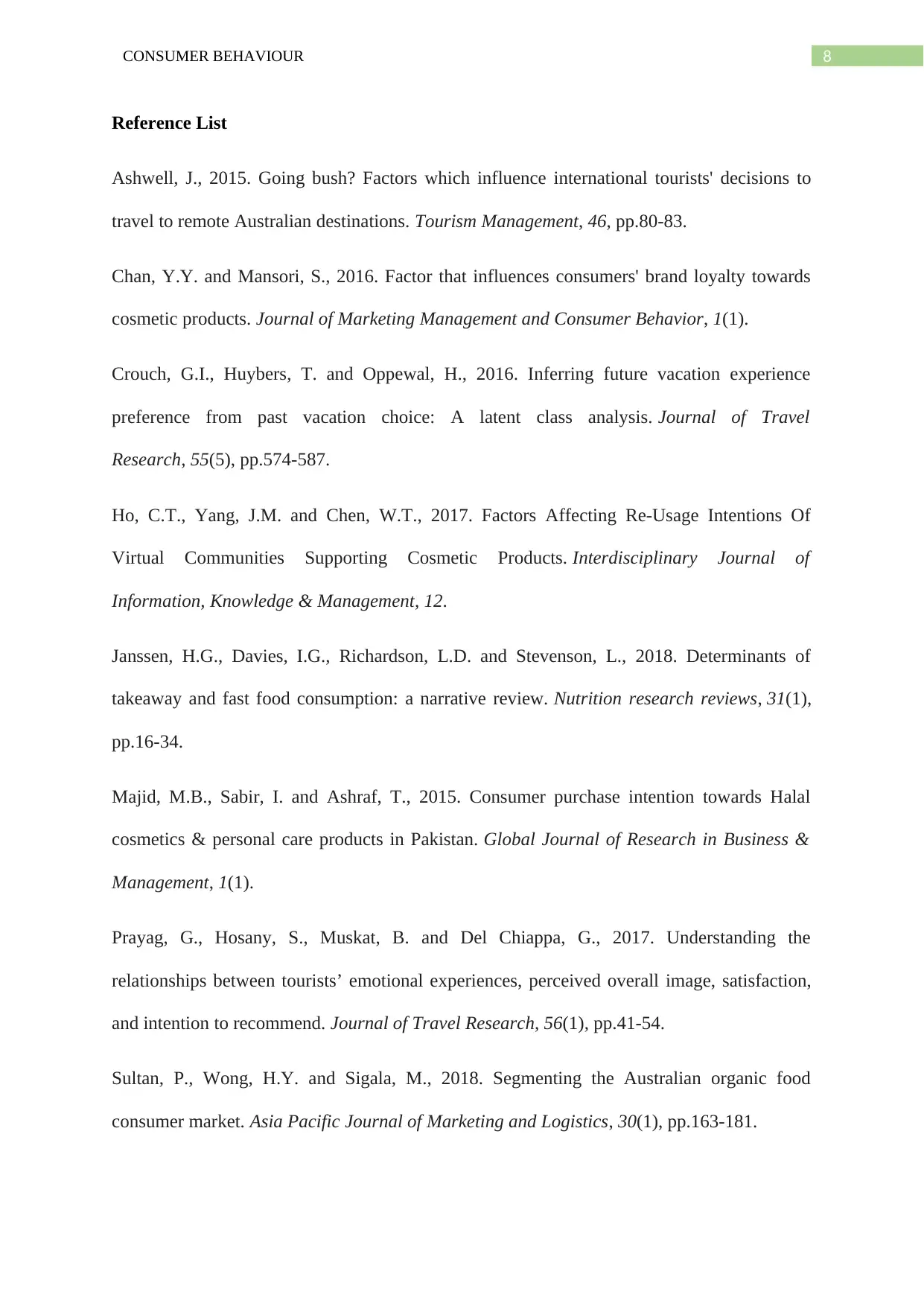
8CONSUMER BEHAVIOUR
Reference List
Ashwell, J., 2015. Going bush? Factors which influence international tourists' decisions to
travel to remote Australian destinations. Tourism Management, 46, pp.80-83.
Chan, Y.Y. and Mansori, S., 2016. Factor that influences consumers' brand loyalty towards
cosmetic products. Journal of Marketing Management and Consumer Behavior, 1(1).
Crouch, G.I., Huybers, T. and Oppewal, H., 2016. Inferring future vacation experience
preference from past vacation choice: A latent class analysis. Journal of Travel
Research, 55(5), pp.574-587.
Ho, C.T., Yang, J.M. and Chen, W.T., 2017. Factors Affecting Re-Usage Intentions Of
Virtual Communities Supporting Cosmetic Products. Interdisciplinary Journal of
Information, Knowledge & Management, 12.
Janssen, H.G., Davies, I.G., Richardson, L.D. and Stevenson, L., 2018. Determinants of
takeaway and fast food consumption: a narrative review. Nutrition research reviews, 31(1),
pp.16-34.
Majid, M.B., Sabir, I. and Ashraf, T., 2015. Consumer purchase intention towards Halal
cosmetics & personal care products in Pakistan. Global Journal of Research in Business &
Management, 1(1).
Prayag, G., Hosany, S., Muskat, B. and Del Chiappa, G., 2017. Understanding the
relationships between tourists’ emotional experiences, perceived overall image, satisfaction,
and intention to recommend. Journal of Travel Research, 56(1), pp.41-54.
Sultan, P., Wong, H.Y. and Sigala, M., 2018. Segmenting the Australian organic food
consumer market. Asia Pacific Journal of Marketing and Logistics, 30(1), pp.163-181.
Reference List
Ashwell, J., 2015. Going bush? Factors which influence international tourists' decisions to
travel to remote Australian destinations. Tourism Management, 46, pp.80-83.
Chan, Y.Y. and Mansori, S., 2016. Factor that influences consumers' brand loyalty towards
cosmetic products. Journal of Marketing Management and Consumer Behavior, 1(1).
Crouch, G.I., Huybers, T. and Oppewal, H., 2016. Inferring future vacation experience
preference from past vacation choice: A latent class analysis. Journal of Travel
Research, 55(5), pp.574-587.
Ho, C.T., Yang, J.M. and Chen, W.T., 2017. Factors Affecting Re-Usage Intentions Of
Virtual Communities Supporting Cosmetic Products. Interdisciplinary Journal of
Information, Knowledge & Management, 12.
Janssen, H.G., Davies, I.G., Richardson, L.D. and Stevenson, L., 2018. Determinants of
takeaway and fast food consumption: a narrative review. Nutrition research reviews, 31(1),
pp.16-34.
Majid, M.B., Sabir, I. and Ashraf, T., 2015. Consumer purchase intention towards Halal
cosmetics & personal care products in Pakistan. Global Journal of Research in Business &
Management, 1(1).
Prayag, G., Hosany, S., Muskat, B. and Del Chiappa, G., 2017. Understanding the
relationships between tourists’ emotional experiences, perceived overall image, satisfaction,
and intention to recommend. Journal of Travel Research, 56(1), pp.41-54.
Sultan, P., Wong, H.Y. and Sigala, M., 2018. Segmenting the Australian organic food
consumer market. Asia Pacific Journal of Marketing and Logistics, 30(1), pp.163-181.
1 out of 8
Related Documents
Your All-in-One AI-Powered Toolkit for Academic Success.
+13062052269
info@desklib.com
Available 24*7 on WhatsApp / Email
![[object Object]](/_next/static/media/star-bottom.7253800d.svg)
Unlock your academic potential
© 2024 | Zucol Services PVT LTD | All rights reserved.





